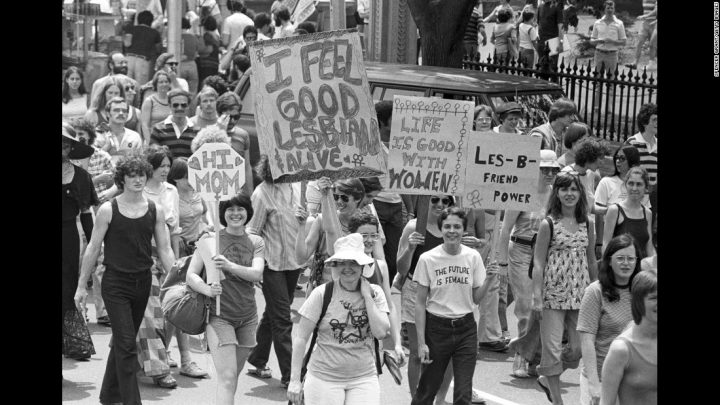By Patricia Smith
June. LGBTQ Pride Month. For years, as a young teacher in Boston, I looked forward to Gay Pride Day (what we called it back then), celebrated in Boston on the first Saturday in June. I went in the early years with my very first girlfriend and I wore, as I saw others had, a paper bag on my head with the word “TEACHER” scrawled on the front. I knew I could get fired if anyone saw me there, if anyone suspected I was gay. I went first to revel in the midst of hundreds of LGBTQ people, of folks who wouldn’t mind if I held my girlfriend’s hand, if we sat in each other’s arms at the festival following the parade. What a comfort to know that at least that many LGBTQ people lived nearby, because growing up in suburban Boston in the 1970’s and ‘80s, I had no clue. I didn’t even have the knowledge that such people existed. Maybe in high school I knew that LGBTQ people existed, but I didn’t know much.
I went to Pride in the following years with my first long-term partner, gathering courage to march in the parade, to be part of the throng of out, proud, LGBTQ people. I marched with fellow members of the Gay and Lesbian Helpline at the Fenway Community Health Center, and I marched with GLSEN, the Gay Lesbian Straight Education Network. For them, I helped carry our banner—“Together, For a Change”—buoyed on with the shouts of the crowd. “Look! Gay teachers!” followed by thunderous applause, smiles, camera flashes. Back then, Pride to me was a sort of Gay Christmas, as much about the celebration as it was about visibility and well, pride. It’s heady stuff to find yourself suddenly with a large tribe when previously you just weren’t sure if there were any other people like you. And then imagine you find yourself with a vibrant, colorful tribe, exuberant in their celebration. Who wouldn’t want to be part?
But this was also the Regan era, the years so many in our communities died from lack of care and attention, the most devastating years of the AIDS crisis before funding and any effective treatments. And then Pride became more than a celebration. It became a way to make our voices heard and our bodies seen. Of course, Pride has always been about making our voices seen and our bodies heard; it was always a way to say “we’re here; we’re queer,” a way to claim the streets just for one day, to demonstrate and revel in our own beauty and strength, to honor and celebrate our lives and, perhaps, with our numbers proclaim our value, to demand attention and insist on our right to exist.
Today, in so many LGBTQ Pride Parades, school groups march. And churches. Employees of big-name corporations. Politicians and families. Straight allies. It’s easy to be cynical about it, all the corporate logos and sponsorships, the not-so-subtle competition for our money and loyalty, all the feel-good rainbows everywhere. But in the throng of now thousands who participate, we can see visible changes to society. We can see more inclusion and acceptance. We can see so many fabulous examples of what it means to be LGBTQ.
But what we can’t see are all the young people who still wonder if there is anyone else like them. We can’t see the harassment, the bullying, the terrorizing that continues—and in many instances has increased—lately. In 2018, EdSource reports that “LGBT young people ages 13-15 are 120 % more likely to become homeless,” even in places like San Francisco, a “gay mecca.” In their 2017 National School Climate Survey, GLSEN reports “fewer positive changes” for LGBTQ youth in schools. The statistics are stark: 98.5 % of LGBTQ youth report hearing gay used in a negative way; 56.6 % report hearing negative comments from teachers and staff. Over half of the LGBTQ students surveyed reported feeling unsafe at school because of their sexual orientation and more than three quarters of LGBTQ students surveyed admitted to avoiding school functions because they felt unsafe or uncomfortable.
The story gets even more grave for trans students. While a little more than half of students surveyed reported hearing anti-gay comments from teachers of staff, the number climbs to 71% who report hearing negative comments from teachers or staff about gender identity or gender expression. From 2013 to 2017, GLSEN reports a “steady increase in negative remarks about transgender people.” Perhaps not surprisingly, students in rural areas, especially in the South, reported the most difficulties in schools and had the fewest resources available to them.
And so—if in a small city nearby—as happened recently in Hendersonville, NC—there is a Pride March or celebration, if there is a visible presence of what it might mean to grow up LGBTQ, if young people can see that it can, indeed, ‘get better,’ that is reason enough to get out there and dance on floats, sing all the songs, march with rainbow stickers. As Harvey Milk said, “You’ve got to give them hope.”
Patricia Smith is the author of the novel The Year of Needy Girls (Kaylie Jones Books, 2017), a Lambda Literary Award finalist. Her nonfiction has appeared most recently in the anthologies Older Queer Voices: The Intimacy of Survival and Nine Lives: A Life in Ten Minutes Anthology as well as Parhelion Literary Magazine, where it was nominated for Best of the Net. Her essay, “Border War,” which appeared in Broad Street Magazine, received a Special Mention by Pushcart. A teacher of American literature and Creative Writing at the Appomattox Regional Governor’s School in Petersburg, VA, she lives in Chester, VA with her partner.






